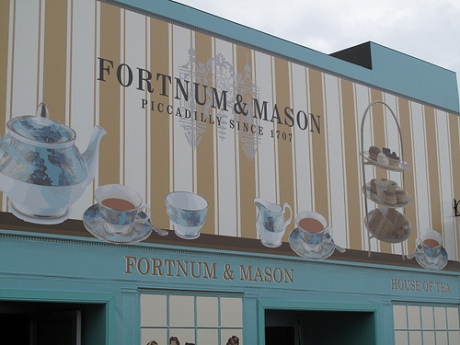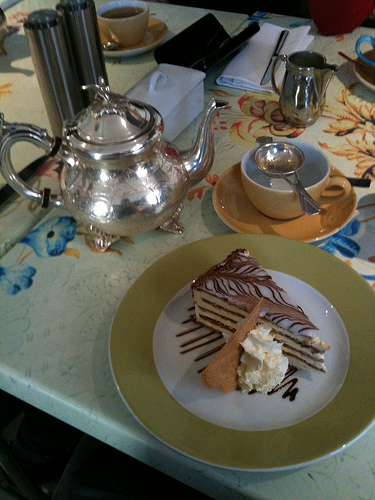London Hotels Insight provides up-to-date, independent advice for your perfect stay in London. We research guest feedback, meet management and identify hotels at the top of their game.
A tea tasting with a Fortnum’s tea buyer.

Fortnum and Mason is like the London headquarters of tea and we were lucky to get a guided tasty from one of their expert tea buyers (image credit below)
I’m not a tea snob.
At home I drink Japanese sencha or Moroccan Mint Tea from Wilkinson’s (an excellent tea shop) or occasionally gunpowder or lapsang souchong. When in Turkey, I drink 15-hour-stewed black tea along with everyone else. And in the office, I used to drink chai masala with a colleague…
But I had never before done a tea tasting, so when I was invited to Fortnum & Mason for a proper tasting in the company of one of their tea buyers, I naturally jumped at the opportunity.
Margot Cooper explained to me how the different types of tea can be distinguished – depending on when the tea is picked, what parts of the tea plant are used (just the tip, or more leaves) and how the tea is processed.
Black tea is fermented for longer – white tea hardly at all. Oolongs are half-fermented. Even how the tea is picked – by hand, or by machine – makes a significant difference. Tea is a true art form.
We tried six different teas, all Fortnum’s blends. All were served in an open cup rather than a teapot, so we could see the leaves – the look of each tea was very different. First, it’s important to concentrate on aroma – a major part of the tea’s character. Then we focused on taste – whether ‘bright’, astringent, ‘warm’, malty, fruity… All the teas were quite different.
- China white – this is a very delicate tea, made just from the tiny bud and the first leaf; the tea estates have special teams of pickers for this tea! A straw or grassy aroma, with a peachy flavour and slightly bitter aftertaste, make up this tea’s very distinctive flavour profile.
- Goomtai darjeeling, first flush (that means it’s a spring picked tea – they’re usually bright and crisp, while the early summer second flush has a warmer flavour and the autumnal picking is darker and richer). I fell in love with this – almost an artichoke aroma, and nicely astringent without being bitter. That’s a typical Darjeeling trait, apparently.
- Lover’s Leap Ceylon had been chosen to show me the typical Ceylon flavour – warm, rich, and slightly malty. I said if it was a colour, it would be a warm orange. Yes, said Margot, and the Darjeeling would be an acid green – that’s the difference.
- The heart of the Fortnum tea range is its blends and Royal blend is a typical breakfast tea, really made for drinking with milk. It’s a Ceylon and Assam mix, and has the typical warmth of these teas – but it’s also quite dry. I have to say it wasn’t … quite… my cup of tea, so to speak.
- Jasmine green tea. I always thought this kind of tea used added flavouring – but apparently not. The tea is dried and fermented on shelves with shelves of jasmine flowers in between – one-to-one for Fortnum’s, but only one jasmine to eight or nine tea for some inferior brands. The jasmine then gets thrown away. The flavour is quite delicate, but the aroma is quite powerful.
- Fort Mason. This is a Fortnums special – orange blossom tea. I thought I’d love it but I actually wasn’t sure; it’s very strong and astringent: not a ‘pretty’ tea at all. I’ll definitely give it another try though.

After tea shopping at Fortnum's, why not retire to one of the store's delightful tea rooms for lovely tea and cake? (image credit below)
Margot told me that tastes differ very widely. For instance, French customers love the aromatic teas – they almost regard tea as a kind of perfume – while many English customers are “dyed-in-the-wool Assam drinkers” who want a good strong black tea.
Meanwhile, Japanese customers all want to have “what the Queen drinks” – they want the most British tea they can get!
Margot also suggested that teas can often benefit from an untraditional approach. For instance, Fort Mason might work nicely if you drank it very strong with milk – and a green tea with Earl Grey works very well cold.
Some blends also go against perceived wisdom. For instance there’s a 75:25 blend of Earl Grey and Lapsang Souchong – ‘Smoky Earl Grey’ – that blends two teas that each have very strong character. You’d think it couldn’t work – chalk and cheese – but it does.
And tea drinkers are becoming much more adventurous than they used to be, apparently – ready to try all kinds of teas, including the flavoured and smoky teas, as well as white and green teas and herbal infusions.
So I inevitably asked Margot: what’s your favourite tea?
“That’s like asking a parent about your favourite child!” she said, admitting that “Everyone asks me that question as soon as they know what I do for a living. But it’s impossible to answer. “So many flavours, so many emotions…I couldn’t possibly have a favourite.”
“All right then; what do you not like?”
That was easy – she came right back this time. “I really don’t like Pu-Erh, it just tastes like earth. Horrible!”
Which may be why it helped Victoria Beckham lose so much weight…
If you’re interested in tea and how it’s made, there are some great articles on the Fortnum’s website in its Tea Magazine. And you might also want to taste London’s best hotel afternoon tea in 2010 according to the Tea Guild.
And if you’re looking for a luxury hotel near Fortnum’s, we’d suggest the impeccable Stafford nearby – the ideal London hotel for wine lovers.
Check the best rate for The Stafford from 30+ hotel booking sites

The Stafford offers a lovely stay in traditional rooms close to Fortnum & Mason
Or maybe the eco-friendly Cavendish – a stylish 4 star hotel right opposite.
Check the best rate for the Cavendish Hotel from 30+ hotel booking sites
Get the best-value London hotel deal from 30+ booking sites in 1 click
Photo credits: Stafford Hotel, 1000heads’ photostream, Rich B-S’ photostream.
Previous post: Tune Hotels CEO talks to London Hotels Insight.
Next post: Time for the hotel pastry chef to star!































{ 1 trackback }
{ 0 comments… add one now }